Mobile broadband coverage and use of mobile internet in Sub-Saharan Africa have shown continued growth over the course of 2017-2022. Contrary to the global trend, Sub-Saharan Africa did not experience a slowdown in the growth rate of mobile internet connectivity in 2022.[1] Around 30 million new mobile internet users came online, matching the growth seen in 2021. However, despite this progress, Sub-Saharan Africa remains the region with the widest coverage and usage gaps (59% and 15% respectively, see Figure 1). Almost half of the 400 million people that lack mobile broadband coverage worldwide live in Sub-Saharan Africa.
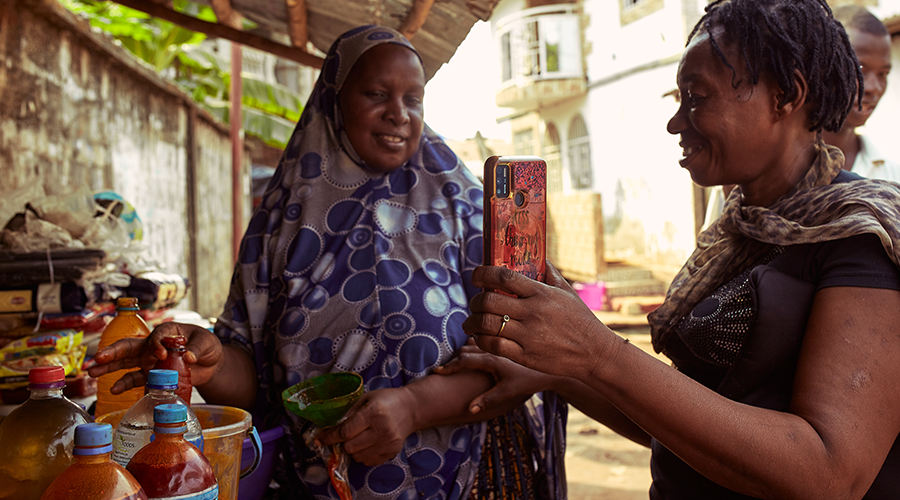
There are two ways people can be ‘unconnected’; either they live in an area not covered by mobile broadband, or they live in an area that is covered but do not use mobile internet.
- ‘Usage gap’ refers to those who live within the footprint of a mobile broadband network but are not using mobile internet services.
- ‘Coverage gap’ refers to those who live in an area not covered by a mobile broadband network.
Figure 1: Evolution of mobile internet connectivity, Sub-Saharan Africa 2017-2022
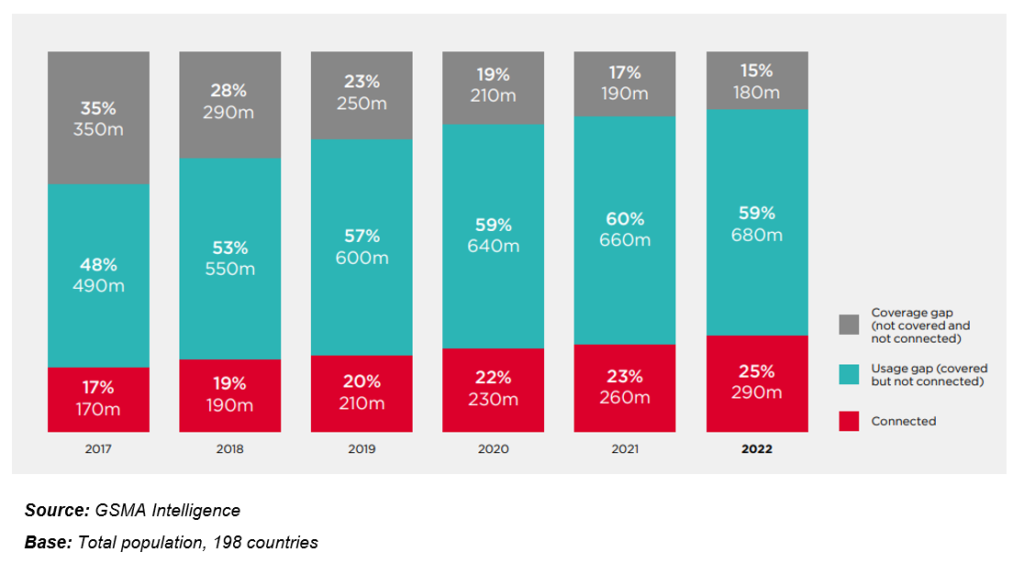
Connectivity varies considerably by demographic
While only 25% of the total population in Sub-Saharan Africa is online (Figure 1), this figure increases to 42% when only considering adults (Figure 2) – the region has a young population and one would not expect certain ages to be connected yet.
Having said this, it’s essential to recognise that internet access can benefit individuals below the age of 18, for instance, by providing access to educational resources. Some organisations explicitly acknowledge the benefits of connecting the youth in their targets, such as the ITU which has set an aspirational target of 100% connectivity for those aged 15+ by 2030 in an effort to achieve universal and meaningful connectivity.[2]
Figure 2: Evolution of mobile internet connectivity amongst adults aged 18+, Sub-Saharan Africa 2020-2022
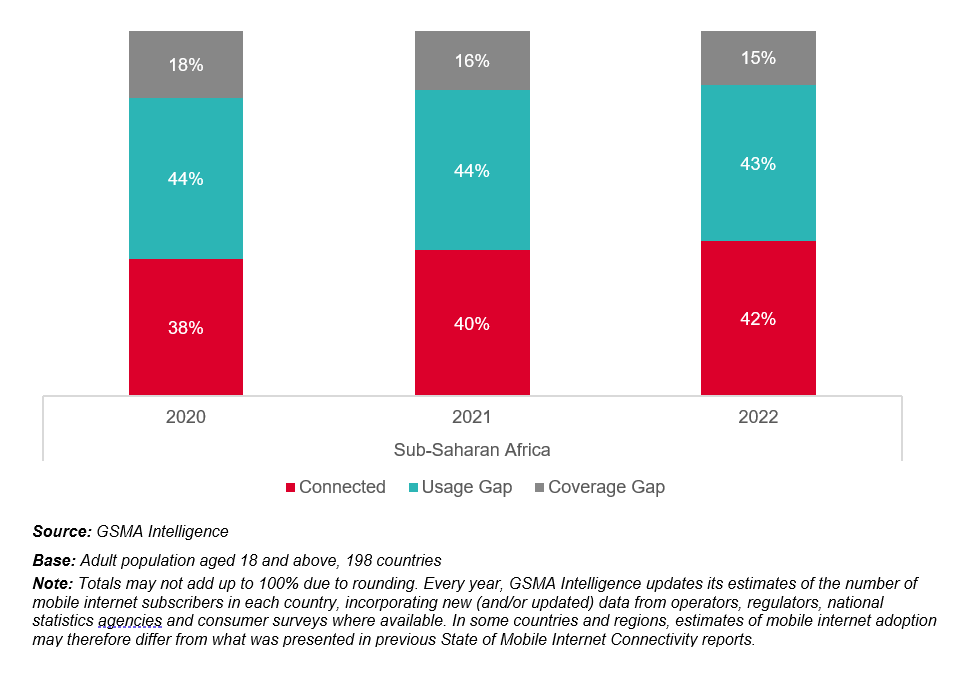
There is also a digital divide between those living in rural and urban areas. In Sub-Saharan Africa, adults in rural areas are 49% less likely to use mobile internet than those living in urban areas. Moreover, women are 36% less likely to use mobile internet than men. Both of these mobile internet gaps remained unchanged in 2022, highlighting the persistence of these inequalities.
Connectivity also varies by sub-region
It is important to acknowledge that significant variation exists at sub-regional level. The coverage gap remains much higher in Central Africa (36%) than in other sub-regions (where it ranges from 11% to 14%). Meanwhile, mobile internet adoption is higher in Southern Africa (33%) than in other sub-regions (ranging from 17% to 27%). It also shows that while the usage gap is a priority overall, in some countries significant efforts are still needed to expand mobile broadband infrastructure. Stakeholders should therefore consider connectivity by different geographies and demographics when informing actions to bring more people online.
4G network expansion has continued at a strong pace
In 2022, global 4G network expansion extended its reach to an additional 195 million people. Notably, more than half of this expansion (101 million) was in Sub-Saharan Africa. 65% of the region’s population now has 4G coverage, compared to 19% just five years prior (Figure 3). Despite these improvements, 69% of smartphones that are connected in the region are still only 3G-capable, a limiting factor in uptake of 4G. Network quality in the region continues to improve, with average download speeds hitting 11.1 Mbps in 2022. Though, this still lags that of other regions, with the global average being three times higher (33.9 Mbps).
Figure 3: Population coverage by technology, Sub-Saharan Africa 2015–2022
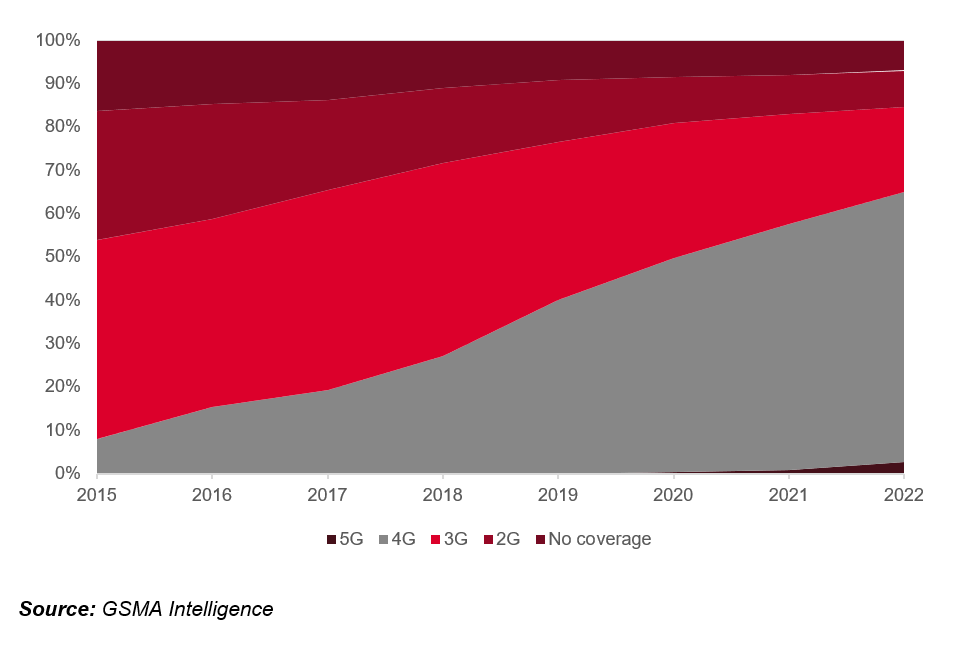
Affordability remains the most significant barrier to mobile internet adoption in the region
While there are a wide range of barriers to mobile internet adoption in the region (see full report), the most commonly reported top barrier has consistently been affordability of internet-enabled devices and data packages. Globally, affordability of entry level internet-enabled devices and data packages remained largely unchanged. In Sub-Saharan Africa, affordability of a device worsened, while affordability of a 5GB data bundle improved (Figure 4).
In Sub-Saharan Africa an entry-level device costs 95% of average monthly income for the poorest 20%.
Figure 4: Affordability of data plans and cheapest internet-enabled handsets across low- and middle-income countries in Sub-Saharan Africa
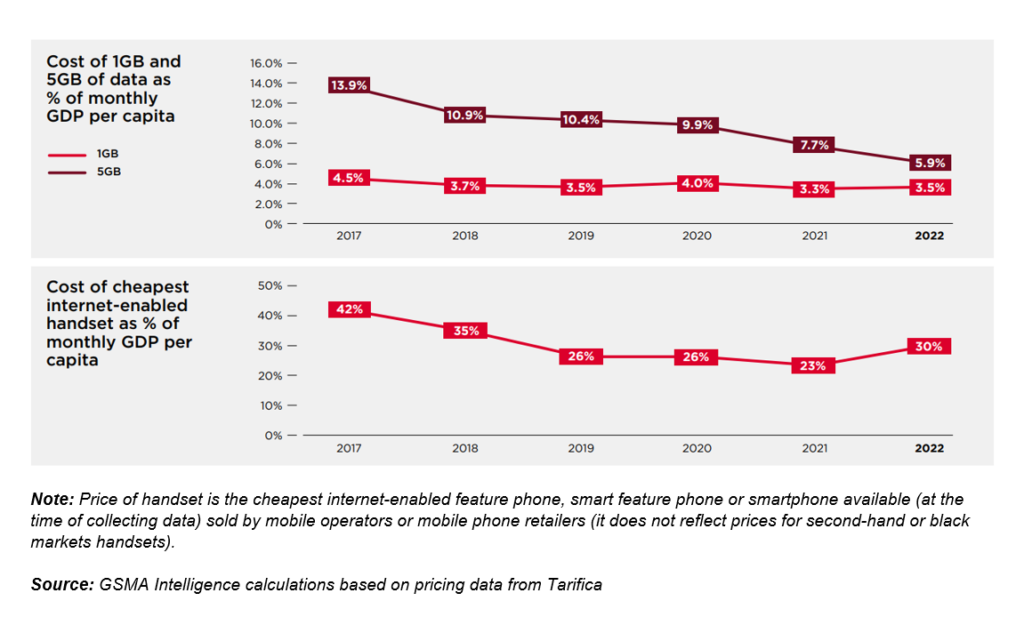
The GSMA has identified three levers to make handsets more affordable:
- Reducing handset costs
- Improving access to financing
- Strengthening the enabling policy and regulatory environment
Ultimately, stakeholders will need to continue working towards better understanding and addressing all barriers in order to tackle inequalities and improve connectivity for all.
Improved mobile connectivity will deliver further benefits to the region
Mobile technologies and services have become an integral part of Sub-Saharan Africa’s economic landscape, contributing 8.1% of the region’s GDP in 2022, totalling $170 billion.[3] Further, studies have shown that expanding mobile broadband coverage can reduce poverty, increase household consumption[4],[5] and that mobile internet is associated with higher levels of wellbeing.[6],[7] Mobile technology can be a force for good, bringing both economic and social benefits, but intentional action is needed to ensure all can benefit.
The State of Mobile Internet Connectivity Report 2023 and the Sub-Saharan Africa factsheets are available here and a recording of our webinar can be found here.
The Connected Society programme is funded by the UK Foreign, Commonwealth & Development Office (FCDO) and the Swedish International Development Cooperation Agency (SIDA), and is supported by the GSMA and its members.
[1] The other being Middle East & North Africa
[2] Achieving universal and meaningful connectivity in the decade of action, ITU
[3] The Mobile Economy Sub-Saharan Africa 2023, GSMA, 2023
[4] The poverty reduction effects of mobile broadband in Africa: Evidence from Nigeria, World Bank, GSMA, 2020
[5] Mobile Broadband Internet, Poverty and Labor Outcomes in Tanzania, Bahia, K. et al., 2021
[6] Mobile Internet Use, Well-being and Gender: Understanding the Links, GSMA 2022; The Impact of Mobile and Internet Technology on Women’s Wellbeing Around the World, GSMA, 2019
[7] The Impact of Mobile on People’s Happiness and Well-Being, GSMA, 2018



